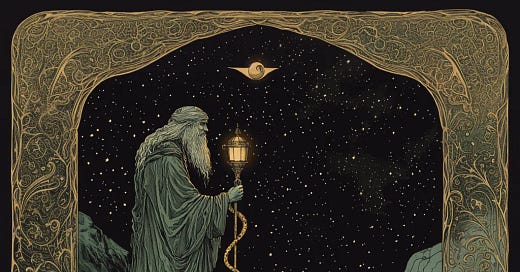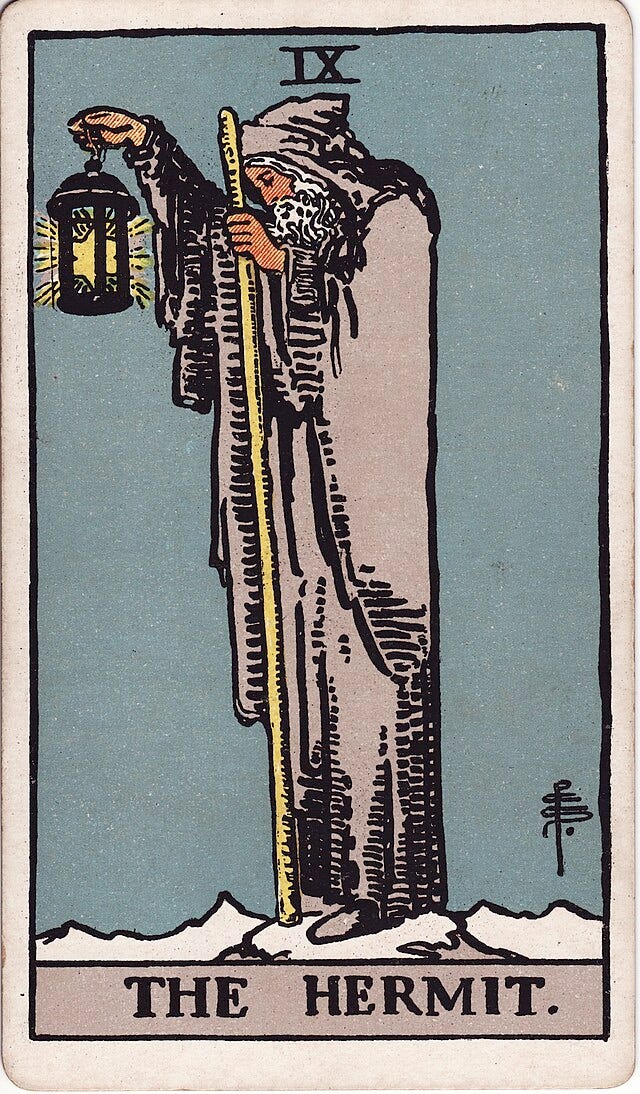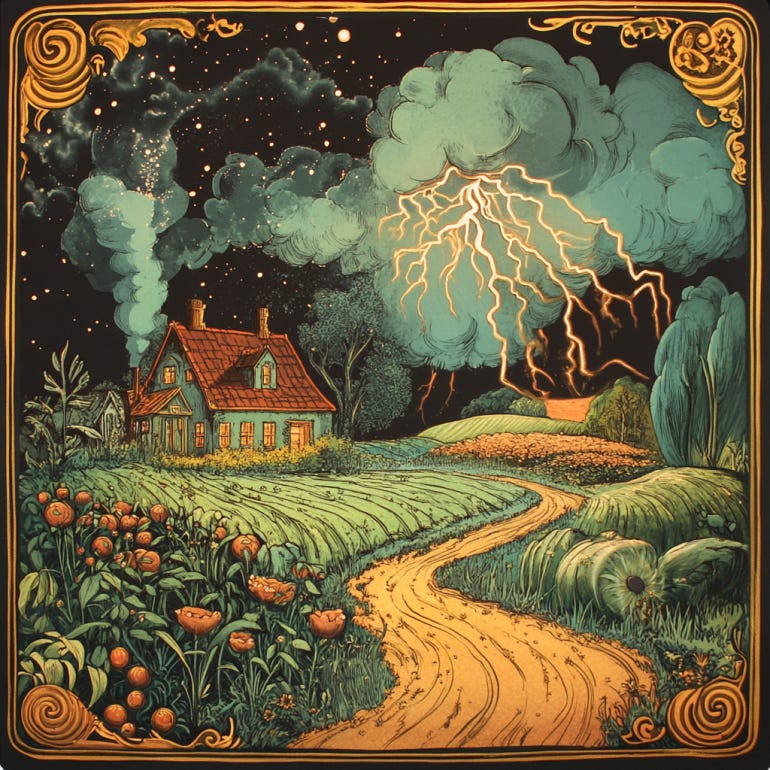Hail, Mercury, traveler between worlds
Divine shapeshifter, trickster teacher,
Stealing ignorance, turning lead into laughter,
Molt us, mold us, make us molten
2025 is a mercurial year.
We can see this in many different ways. First, numerologically: 2025 is reduced to 9 (2+2+5), which is the number of the Hermit in the Tarot, which is associated with Virgo, a sign ruled by Mercury. This is the form of Mercury as an elder, an adept who has achieved transformation and illumination and engages with the world as if from on high, performing some subtle, compassionate alchemy. Mercury would also delight in the nature of the number 2025 itself—it’s has the square root of 45, and the next year that will have a square root is 2116. Likewise, 2025 is the start of the second quarter of this century—as if it were the second quarter of a sports game, it’s started with a bang.
Second, this is the year of the Earth Snake in Chinese Astrology. While technically, the Spleen, the Yin organ related to both the Earth element and the Snake, is ruled over by Saturn in Chinese Astrology, the Spleen is very mercurial, said to rule over transformation and transportation—Mercury themes. Earth is the element of the center, ruling over the changes between the seasons and the pivotal moments between them when folks tend to get sick. Likewise, the Snake itself is distinguished by its cunning and capacity to molt, features that Mercury excels in. Perhaps the seasons that Mercury goes retrograde could be indicators of when these moltings or major adaptations will be occuring, and certainly this spring, when Mercury and Venus go retrograde amidst eclipse season, will be a major one—the pieces are already falling into place for that. The Hermit card could be a helpful guide to meditate upon.1
Additionally, through the first half of this year, Jupiter, who spends about 12 months in a sign, is in Gemini, which is also ruled by Mercury. Jupiter depicts where we find expansion, growth, and wisdom, in a manner that encompasses, harmonizes, and makes things whole. Although Jupiter is technically in detriment in Geminim and thus, this quality of expansive whole-making is weakened, it can still be achieved by diving into the small details of life, finding tiny moments for playful growth and developing mastery over the quick distractions that end up deflting us and sapping our momentum. Personally, I’ve found renewed delight in the small elemental building blocks of life—more delight and magic in colors, numbers, and words.
Beyond an awareness that Mercury’s retrogrades could be extra important in this Snake year, the exact rhythm of Mercury’s serpentine dance in relationship to the Sun is instructive as to how our internal metamorphoses might unfold. Likewise, tracking Mercury’s rhythm can help us feel into the ebbs and flows of our own interests, ideas, and communicative flow with the world. When Mercury is moving rapidly, as they are now, these things flow rapidly—sometimes too fast, with things getting slippery and dispersed. Our minds are wide open, with Mercury zooming around the other side of the Sun from our perspective, as if taking a panorama of the cosmos. Mercury moves at up to two degrees of the zodiac per day, covering territory quickly, getting fascinated and bored quickly, and then comes to a halt, spending up to two weeks in the same two degrees of the zodiac, as if microscoping down into a particular niche or getting hooked on a particular plotline.
These concentrated moments happen on the two sides of Mercury’s retrograde, which itself takes place in a relatively focused area. Altogether, throughout a year, Mercury spends as much time in the element that they go retrograde within as the other three elements combined, a phenomenon called the Mercury Elemental Year. At the moment, Mercury is transitioning between a Fire and Water elemental year. Last year, they occured entirely within Fire signs. Our retrogrades in March and November will start in Fire signs, but then move back into Water signs, where they will end. The retrograde in July and August will take place entirely within Leo, a fire sign. Thus, a lot of the magic that we might experience could take place around Fiery subjects—our sense of vitality, will, enthusiasm, desire, and initiative—as well as Watery ones—our relationship with our interior, our emotional lives, our relationships, and our imaginative lives.
Mercury takes three retrogrades every year, which might correlate to the name of Hermes’ Hellenic combination with the Egyptian Thoth, “Hermes Trismagistus”, or Hermes the Thrice-Great. Within these three retrogrades, though, Hermes makes six conjunctions with the Sun—three while Mercury passes in between the Sun and the Earth, at the middle of the retrograde cycle, and three while Mercury zooms around the other side of the Sun from our perspective on Earth. This latter moment is happening today. Altogether, when mapped out on the zodiac over a year, the six Cazimis create a six-pointed star like the Star of David, which is traditionally depicted as the light in the middle of the Hermit’s lamp. These moments are useful as checkins with our higher self, as Mercury’s capacity to act as a conduit and communicator with the Sun is heightened.
After moving at a pretty quick clip through Aquarius and Pisces in February, Mercury will start slowing down in Aries in early March, in order to go retrograde on March 15th in a conjunction with Venus in Aries. The next major midpoint between Mercury and the Sun is on March 24th, the second point in our six-pointed star. Mercury’s retrograde then ends on April 7th, in a conjunction with Venus, Saturn, the North Node, and Neptune in late Pisces. As I said, this will likely be a very major timeperiod of reconfiguration, and it would probably be great to ritually dive into it. I’ve been thinking about how these Venus and Mercury retrogrades generally coincide with Lent this year (March 5 - April 17), so perhaps it could be nice to hop onto that egregore of renunciation in some way. It’s very much worth checking out where late Pisces and early Aries fall in your natal chart to understand where the action is happening in your life.
From mid-April through mid-July, Mercury will be zooming along again, speeding through Aries, Taurus, Gemini, and Cancer before slowing down in Leo. The next, third point in our six-pointed star will happen on May 30th, at 8 degrees Gemini. The next week, Jupiter will leave Gemini, moving into Cancer. Jupiter is exalted in Cancer—it’s a place he likes to be, where he’s strong, and the fortunate qualities of life can flourish. This is a dramatic transition from Jupiter’s detriment in Gemini, and it shifts energy away from the cacophany and multiplicity of Gemini toward more coherent and cozy processes of growth—and growth here happens organically, with agricultural metaphors being appropriate for Cancer. This placement for Jupiter’s exaltation reminds me of the central idea of cultivation in many Asian systems of meditation/spiritual growth. The term is used commonly in Chinese internal alchemy (Nei Gong), as well as being the original term used for meditation in Pali, the language that the Buddha spoke—bhavana. Loving kindness meditation, for example, is mettabhavana.
Shortly thereafter, though, on July 7th, Uranus moves into Gemini, kicking off an era of extreme Gemini energy which will last till 2033. Uranus in Gemini will intensify and accelerate some of the chaotic, ADHD-type dimensions of the digital era, bringing it to a fever pitch. At the same time, this is a place of elevation for Uranus, who is sometimes considered a higher octave of Mercury—the electricity to Mercury’s wind. Uranus in Gemini will bring forth great innovation and awe-inspiring feats of ingenuity. If you, yourself, are involved with any sort of electric brilliance, this will be a time in which it starts to come more intensely online. Uranus will, however, go back into Taurus on November 8th for six months or so, before making a final ingress into Gemini next spring.
Mercury will go retrograde on July 18th at 15° Leo. The midpoint of that retrograde will be July 31st (Harry Potter’s birthday, point 4/6), and then Mercury will be direct again at August 11th, at 4° Leo. This Leo retrograde will reorganize and revitalize our creative and brave sense of self. It will likely be a fun, playful, and slightly dramatic time period. We had a Mercury retrograde in Leo around the same time last year, which might be good to reflect on—this is round two, in a way.
Mercury will then start picking up speed again through the end of August, entering Virgo on September 2nd, where we’ll have the 5th of our cazimis on September 13th. Mercury will move ingo Libra on September 18th and then Scorpio on October 6th. The final Mercury retrograde of the year will occur with Mercury in a long conjunction with Mars, which will likely make things sharp and spicy—it might be a fall will a good deal of commotion and conflict, and we’d do well to have some project to direct that constructively toward. That retrograde will start on November 9th at 6° Sagittarius, close to the fixed star Antares. The sixth cazimi of the year will happen on November 20th, which will also be a New Moon, at 28° Scorpio, before the retrograde ends on November 29th.
As always, please reach out for a reading, if there’s anything I can do to be helpful.
Warmth,
Charlie
It’s definitely interesting to think of Saturn as the ruler of the Earth element and Mercury as the ruler of the Water element. On a simple level, Saturn as a slower, grounded energy and Mercury as a quickly moving one definitely makes sense. Here, I can think of Saturn as a sort of still center point around which transformation can take place, and Mercury’s spirit as the dancing fluidity that Bruce Lee was getting at when he said, “Be like water, my friend.” In other attribution systems, too, Saturn is given to the spleen—Rudolf Steiner says that the spleen is like a miniature Saturn which enables our capacity to have varied eating times and maintain equilibrium. Thanks, Saturn. Modern day practitioners of Chinese Medicine think that the organ named Spleen might actually be closer to the modern-day pancreas, though, as the spleen is understood to be connected to the immune system in modern medicine, rather than the digestive/metabolic attribution of the Spleen and the Earth element in TCM. Regardless—even if we think that Saturn should be the ruler of the Spleen, the Hermit could still be considered a nice blend of Saturnian and Mercurial energies.






